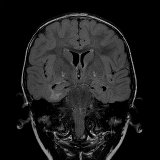Late-Onset Spasms in Association With Temporal Lobe Lesions: Two Different Approaches With Similar Outcome
Abstract number :
2.155
Submission category :
4. Clinical Epilepsy / 4C. Clinical Treatments
Year :
2018
Submission ID :
502679
Source :
www.aesnet.org
Presentation date :
12/2/2018 4:04:48 PM
Published date :
Nov 5, 2018, 18:00 PM
Authors :
Dana Marafi, Baylor College of Medicine; Michael M. Quach, Baylor College of Medicine; and Rohini Coorg, Baylor College of Medicine
Rationale: To describe two cases of late-onset epileptic spasms in association with a temporal lobe lesion Methods: Retrospective chart review of two cases with late-onset epileptic spasms and temporal lobe lesions referred to the Texas Children’ Hospital (TCH) Blue Bird Circle Clinic (BBC) Comprehensive Epilepsy Clinic between 2016 and 2018 for pre-surgical evaluation. Results: Both cases were males with onset of seizures at 2 years of age. The first patient was initially diagnosed with night terrors after experience episodes of nocturnal arousal with confusion. Epilepsy was first suspected after experiencing a daytime episode of eyes deviation, unresponsive and confusion. Seizures quickly became refractory to 3 antiepileptic medications (levetiracetam, oxcarbazepine, and clonazepam). Brain MRI showed non-enhancing hyper-intense T2 lesion in the right inferior temporal lobe concerning for low-grade glial neural tumor versus superimposed cortical dysplasia [Panel-1]. Epilepsy Monitoring Unit (EMU) study captured multiple clusters of epileptic spasms in the setting of a diffuse background slowing consistent with encephalopathy. A craniotomy followed by right anterior temporal lobe resection was performed and resulted in sustained seizures freedom at 1.5 year follow up. Surgical pathology showed evidence of mild cortical dysplasia with giant neurons, remote cortical infarct with cystic formation and diffuse cortical and white matter gliosis.The second patient was also a diagnosed with epilepsy at 2 years of age. Concern for seizure arouse when parents noticed episodes of head bobbing along with developmental regression. Initial EEG was consistent with hypsarrhythmia. Topiramate was initiated and titrated up to 10 mg/kg/day without improvement. Brain MRI showed right greater than left temporal abnormalities with cystic changes, concerning for cortical dysplasia versus low grade tumor [Panel-2]. During the EMU admission, several infantile spasms arising from the right temporal region were captured the setting of diffuse background slowing consistent with encephalopathy. He was started on vigabatrin with complete resolution of the spasms within 4 days. The patient remained seizure free at follow up after 1.5 years. Conclusions: These two cases highlight the importance of early transitioning of subjects with late-onset spasms in association with focal lesions into a tertiary epilepsy center. Trialing other antiepileptic medications while pre-surgical evaluation is ongoing should be considered as it may lead to potential therapeutic outcomes. Funding: Not applicable

.tmb-.png?Culture=en&sfvrsn=557a0edb_0)